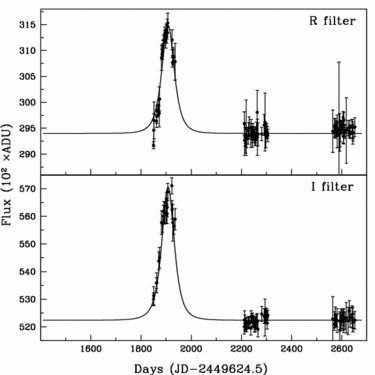



Recent years have seen rapid advances in our understanding of the nature of dark matter in the Galaxy. Much of this progress has come from the studies of gravitational lensing, a phenomenon of temporary amplification of the flux of a background star when a foreground object (called MACHO which could be an unseen object) passes close to our line of sight to this background star. Several groups (e.g. MACHO, EROS and OGLE) have been implementing this technique since 1990 and detected a large number of microlensing events. However, these groups are mainly confined to nearby regions (Galactic bulge and Magellanic Clouds). During last decade, M31 has also become a prime target for the microlensing search and various groups (e.g. AGAPE, POINT-AGAPE, MEGA and WeCAPP) have reported many microlensing candidates towards M31.
However, such a search in the halo of any other galaxy other than the Milky Way is difficult since most of stars in these galaxies are unresolved from the ground based observations. To cope with the problem, it was proposed to monitor the flux of the CCD pixels rather than the individual stars. In recent years few groups have initiated the monitoring of M31 with an aim to detect microlensing events using pixel technique. We started CCD observations of M31 under a survey named Nainital Microlensing Survey in 1998 in collaboration with the College de France, Paris (AGAPE collaboration).
During 1998-2002, we have carried out a microlensing survey named 'Nainital Microlensing Survey' using 1.04-m telescope at Nainital (alt ~ 1950 m) in India to detect microlensing events in the direction of M31. The target field centered at RA = 00:43:38, DEC = +41:09 and covered an area of about 13x13 square arcmin field using 2Kx2K CCD chip in the disk of M31. The mean psf seeing during our four year observations was 2.2 arcsec.
The data has been analysed using pixel method which is based on the enhancement of flux of a CCD pixel rather than the detection of resolved stars. The basic principle of the pixel method is that if a star is brightened in a crowded field, then by subtracting the original flux from the amplified flux of the star, one gets an increase in flux. Thus by following this brightness variation of the pixels of the CCD detector with time, we can monitor the variation in the flux of the target star, although this change should be significantly above the fluctuation level.
After four year long observations, we detected a microlensing event NMS-E1 at RA = 00:43:33.3 and DEC = +41:06:44, about 15.5 arcmin to the South-East direction of the center of M31. This was the brightest microlensing event reported to M31 at that time. The peak brightness of the event Rmax ~ 20.1 mag coupled with its red colour (R-I) ~ 1.1 mag and half intensity duration of t_{1/2} ~ 59 days lends supports to it being a red giant source. Moreover, the half intensity duration along with its location in M31 disk suggest that the lensing event might be due to halo lensing, either due to M31 halo or halo of our own Galaxy. However, non-detection of source star in the absence of lensing phenomenon prevents us to determine Einstein crossing time hence the mass of the MACHO.
The figure in the left side is the pixel light curves for the microlensing candidate NMS-E1 in R and I bands. Event was tracked down during 1999-2001 which was reached at maximum brightness around 18 December 1999.
(see detail on Joshi et al. (2005))
It is worth to note here that we have now stopped observations in the Nainital Microlensing Survey.
Dr. Yogesh C. Joshi
Scientist-F
Aryabhatta Research Institute of Observational Sciences (ARIES)
Ministry of Science and Technology, Govt. of India
Nainital-263001
India
Office Room: 125
New Building, First Floor
Office Phone: +91-(0)5942-270754
Office Extn.: 754
Email: yogesh@aries.res.in
Last modified Tuesday, 01 July 2025